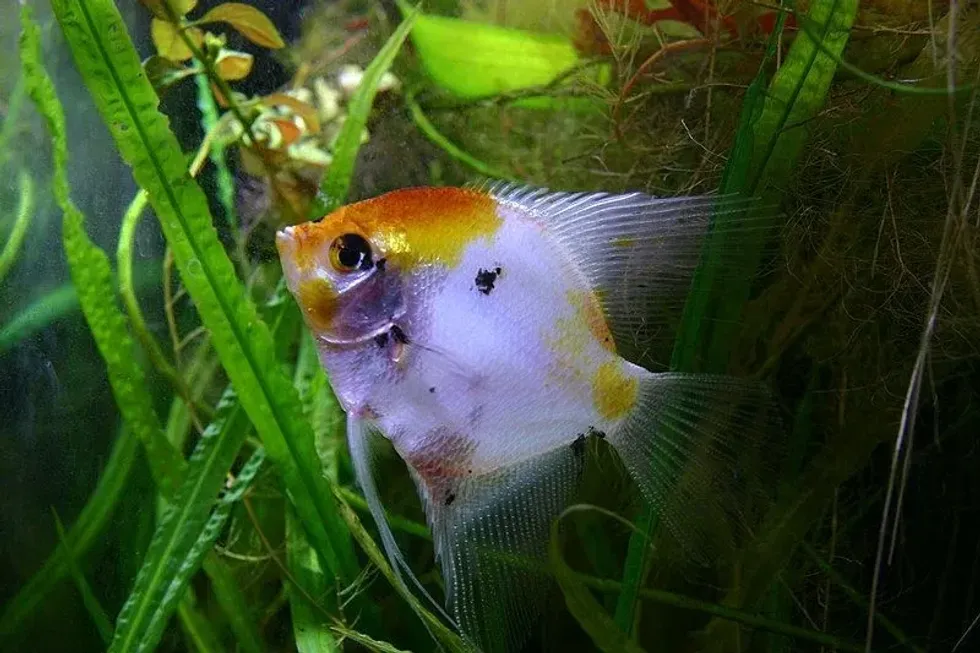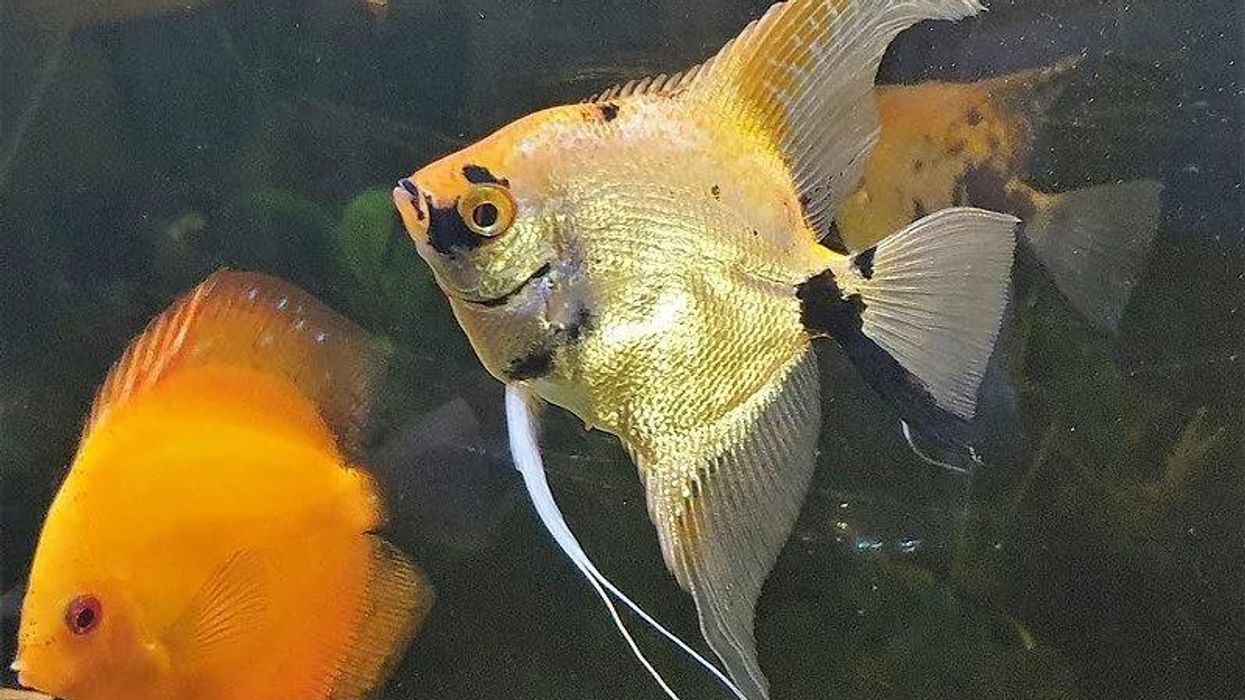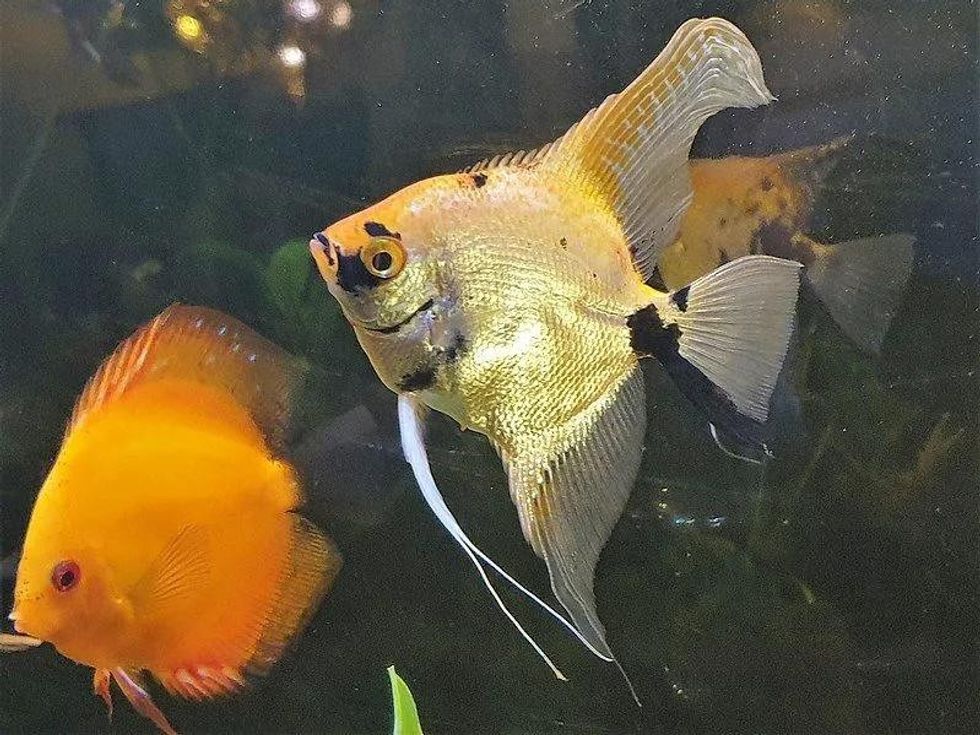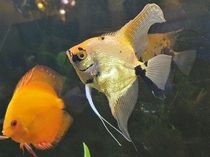Fun Angelfish Facts For Kids

Content
- What type of animal is an Angelfish?
- What class of animal do an Angelfish belong to?
- How many angelfish are there in the world?
- Where does an Angelfish live?
- What is an Angelfish's habitat?
- Who do Angelfish live with?
- How long does an Angelfish live?
- How do they reproduce?
- What is their conservation status?
- What do Angelfish look like?
- How cute are they?
- How do they communicate?
- How big is an Angelfish?
- How fast can an Angelfish swim?
- How much does an Angelfish weigh?
- What are their male and female names of the species?
- What would you call a baby Angelfish?
- What do they eat?
- Are they aggressive?
- Would they make a good pet?
- Did you know...
- Types of Angelfish
- Having your own Angelfish
Are you looking for a perfect fish for your tank? Then the Freshwater Angelfish is the species you have been looking for!
This freshwater fish is a popular tank fish with vertical stripes, friendly nature, and more. They belong to the Pterophyllum family. Though they have a fixed water temperature range, the Freshwater Angelfish is a fish breed that requires little care otherwise.
In the wild, you can find them in tropical rivers and freshwater lakes all over the world, but especially in Colombia, Brazil, Guyana, French Guiana, and Peru. In captivity, the P Altum is a favorite of the people.
Depending on the species, they have a variety of Angelfish lifespan, Angelfish size, shapes, and variations amongst them. With over 90 species of this animal, there is no shortage as to the variety of this tropical family of fish.
Some are as large as 13 in long, whereas others are less than 7 in long. There is also great variation in their care, behavior, tank requirements, pair, breeding, type of water, and other aspects of Angelfish care.
Are you curious about the various Angelfish types, Angelfish temperature, Angelfish facts, Angelfish care, Angelfish food, Angelfish eggs, Angelfish breed, and more? Then read on to know all about them. Still interested in fish? Then do check out the tetra and cichlid too.
Angelfish Interesting Facts
What type of animal is an Angelfish?
Angelfish is a type of fish.
What class of animal do an Angelfish belong to?
Angelfish belong to the fish class.
How many angelfish are there in the world?
There are about 90 species of marine Angelfish.
Where does an Angelfish live?
Angelfish lives in the ocean. Some of the other variety of Angels can be discovered in every ocean in the world
What is an Angelfish's habitat?
Angelfish live nearly entirely in calm, slow-moving water. The majority of these fish have dazzling colors that allow them to blend in with the brightly colored reefs, algae, and other features of their coral reef environment.
Who do Angelfish live with?
Young freshwater Angelfish often live in a group, but adults prefer a solitary life. When angelfish reach maturity, they become extraterritorial and violent towards another fish.
How long does an Angelfish live?
In the wild, Angels have been recorded to live up to 10 years. In captivity, if taken care of well, Angels can live up to 15 years too.
How do they reproduce?
Mature angelfish readily pair up and spawn. They clean an even vertical surface to lay their eggs on and scare away other fish.
Spawning occurs when the female lays a series of eggs on the already prepared facade, which the male fertilizes. The breeding age of Angelfish between the ages of 6-12 months. We have to set up a freshwater aquarium large enough to prepare breeding Angelfish.
What is their conservation status?
Angelfish's conservation status is not extinct. Most species have been marked by the IUCN Red List as a species of Least Concern. The Emperor, the French, the Yellow, and Blueface Angelfish are a few species with that designation.
Angelfish Fun Facts
What do Angelfish look like?
Angelfish have a circular body outline and elongated triangular dorsal and anal fins, making them oddly shaped for cichlids. Because of their unusual diamond-shaped body, they can easily conceal and travel around roots and plants.
Angelfish can attain lengths of up to 6 in and have impressive fins that can reach ranges around 8 in. They have a shape resembling arrowheads, with wide bodies and triangular snouts. The most iconic feature is their trailing dorsal and pectoral fin and their wide fan-shaped caudal fin.

How cute are they?
These fish are uniquely cute with their tall, pointed fin and their beautiful sparkling scales. Marine Angelfish can sometimes be red, gray, blue, or yellow in color, with a variety of colorful markings and lines. Angelfish in freshwater can be silvery-blue in color and have dark, longitudinal streaks
How do they communicate?
Angelfish, demonstrate social status using chemical signals carried in the bile and urine they release into the water. The bright-colored body of marine Angelfish provides them camouflage in the coral reefs in the ocean and plays important role in communication.
How big is an Angelfish?
Angelfish can be up to 2-24 in long. Male and female Angelfish are difficult to distinguish since they are the same size and have the same body coloration. Both freshwater Angelfish and marine Angelfish have laterally compressed, thin frames, small mouths, and long dorsal and anal fin.
How fast can an Angelfish swim?
Angelfish are slow swimmers and they cannot cope with strong currents in the water so there should be less current of water in the tank
How much does an Angelfish weigh?
Most Angelfish are weighed at up to 2 lb. The weight of Angelfish depends upon their species and body length.
What are their male and female names of the species?
There is not any specific name of male and female species.
What would you call a baby Angelfish?
Baby angelfish, also known as fry, live inside the eggs for a while after hatching, feeding on the remaining yolk in the egg sac. Angelfish fry grow to be free-swimming shortly after detaching from their eggs when they take their nutrients from water and plants.
What do they eat?
A healthy, well-balanced diet plan for the freshwater Angelfish includes pellets, flaked, that may be frozen, or live. Bloodworms, Mysis shrimp, and brine shrimp are all common treats for freshwater angelfish. Marine Angelfish eat mostly sponges, algae, shrimp pieces, and plankton.
Are they aggressive?
Some species in the cichlid family are known for their aggressive nature, but angelfish are not usually violent. Angelfish are a pretty stable breed, so they do well in a tank with other fish with the same disposition.
Sometimes they can be aggressive toward one another, particularly when breeding season is on the rise.
Sometimes these fish become aggressive due to establishing themselves at the highest rank in the tank. To reduce the aggressive behavior of fish, you have to ensure that the tank is not overcrowded and fish have been provided with adequate hiding places
Would they make a good pet?
Angelfish are rewarding species for hobbyists. Even though Angelfish can be difficult to care for, they aren't as difficult as some of their other cichlid relatives, such as the lesser-known discus fish.
The Angelfish tank size is large and needs very clean water and appropriate food. The behavior of Angelfish is timid and gets scared easily by loud noises and sudden moves.
Even though they have been called group fish, they can become quite aggressive if not held with the appropriate species. Angels are omnivorous, and will not hesitate to eat any smaller fish in their tanks.
Did you know...
One of the most interesting facts about Angelfish is it changes colors as it gets older. A young Angelfish’s blackish stripes may fade into yellow ones as they grow older. Nutrition, breeding, and health activities can also cause color changes.
Fun facts about Angelfish are that a female changes into a male at a certain point in her life, which is known as protogynous hermaphrodites.
Angelfish facts for kids include that the body shape of an Angelfish is thin and flat like a pancake. This facilitates them to slip through the narrow holes and crevices in coral reefs. This way they can escape a predator or access other plant life or algae for nourishment.
Also, Angelfish know their owner and may recall a human figure for months or years. Not just that, but Angelfish form a bond with their owners.
Types of Angelfish
The Emperor Angelfish is one of the larger species at 15.8 in long. Adults are easy to recognize because of their vibrant blueish and yellow stripes. Their diet is sponge and algae from on and around coral reefs.
The Queen Angelfish is sometimes also called the Blue Queen. It is a large species measuring 18 in long. They can be blue and yellow or blue in color. This fish's primary diet consists of sponges. It also consumes jellyfish.
The French Angelfish is black with yellow circles around its eyes. The habitat of this fish is coral reefs in the eastern region of the Caribbean. Like most of the species, sponges are the main diet of this fish.
Angelfish bred for their brownish-black and white hue are known as Koi Angelfish. The heads of certain fish may have golden color markings. Young people may have a reddish tint under their eyes, which fades as they get older. These are lovely Angelfish, and just like Koi, their shading and hues can differ.
Depending on their mood Koi Angelfish change color. When they become stressed, the orange tone becomes darker. The Diet of Koi Angelfish is a variety of foods including vegetables as well as meaty foods.
If you are looking for common dwarf Angelfish, then the Flame Angelfish should be on top of your list! It has bright red or orange-colored body and horizontal black-colored stripes along the caudal segment of the blueish-tipped dorsal and anal fins.
It has no recognizable differences in color between male to female. The diet of this saltwater Angelfish should consist of marine algae, Spirulina, and other high-quality meaty items.
Altum Angelfish is a stunning fish with clear vertical stripes and long dorsal and anal fins. Light brown and dark chocolate colors occur in place of the silver and black colors of the common.
It is a carnivore and stealth predator. Newly introduced fish would most likely need live foods, but if they are fed well, they will accept frozen foods as well.
Regal Angelfish are saltwater aquarium fish for marine aquariums. This fish feeds primarily on sponges and tunicates in the wild. In the aquarium, these fish feed a varied diet. These fish will grow to be about 9.8 in long and have white and orange lines with blue and black edges.
The peppermint Angelfish is a relatively smaller fish of marine ray-finned fish. Its diet is little known but thought to be made up of worms, crustaceans, sponges, tunicates, and such.
The Black Angelfish is a classic Angelfish species that is long-beloved in the aquarium hobby. Feeding is simple for these smaller fish. Black Angelfish are attractive fish and are also well-behaved. These are ideal for planted aquariums and it is also possible to breed them in the aquarium.
The Pygmy Angelfish is also called the Cherubfish or Cherub Angelfish.The scales are dazzling sapphire-blue along with orange highlights. Plankton, sponge, and different types of filamentous marine algae are eaten by these Angelfish.
The Blue Angelfish may also be known as the Common Angelfish. It has an aqua coloration with a gold tint and yellow edges on the fins and scales. The adolescent Blue Angelfish has a yellowish-brown overall color and pale-blueish markings, which distinguishes it from the parent. These fish eat marine algae, Spirulina, mysis, superior-grade Angelfish preparations, or frozen shrimps.
Having your own Angelfish
Angelfish may be kept in a group tank as long as tankmates of these fish aren't particularly competitive or fin nippers. High-speed-moving fishes can also frighten Angelfish and compete for food with them. In a 30-gallon aquarium, no more than one pair can be kept.
Keeping many Angelfish necessitates specialized husbandry, large tanks, constant commitment, careful preparation, and a dash of chance. The Angelfish's territoriality necessitates the imposition of these criteria. It is best to keep no more than two Angelfish in a single tank.
We can put Boesemani Rainbow Fish, Corydoras Catfish, Dwarf Gourami, Zebra Loaches, and similar animals with the Angels. Angels prefer water with a pH between 6-7.5.
Where the pH difference between both the bag and Angelfish tank water is higher than 0.4, susceptible fish are much more likely to struggle and possibly die as a result of the transition. These fish can survive for 10 years or more and tend to be housed in ponds of other fish of their genus.
Angelfish can reach up to 6 in long and therefore should be stored in a tank no less than 20 gallons in size. As a result, Angelfish tanks should be large - the larger, the better.
These are tropical fish that flourish in warm water conditions, with temperatures between 75-82°F. Their water conditions are often acidic, with little to no salinity. Water conditions in which they live are swampy, with a fine sandy substrate and lots of aquatic vegetation and mosses for hiding.
Here at Kidadl, we have carefully created lots of interesting family-friendly animal facts for everyone to discover! Learn more about some other fish including rainbow cichlid, or electric blue Jack Dempsey.
You can even occupy yourself at home by drawing one on our angelfish coloring pages.
We Want Your Photos!
More for You
Sources
https://www.aqueon.com/information/care-sheets/angelfish
https://small-pets.lovetoknow.com/fish/10-facts-about-angelfish
https://a-z-animals.com/animals/angelfish/
https://kidskonnect.com/animals/angelfish/
https://www.fishlore.com/Profiles-Angelfish.htm
See All
Bachelor of Arts specializing in English Language, Master of Philosophy

Devangana RathoreBachelor of Arts specializing in English Language, Master of Philosophy
Devangana is a highly accomplished content writer and a deep thinker with a Master's degree in Philosophy from Trinity College, Dublin. With a wealth of experience in copywriting, she has worked with The Career Coach in Dublin and is constantly looking to enhance her skills through online courses from some of the world's leading universities. Devangana has a strong background in computer science and is also an accomplished editor and social media manager. Her leadership skills were honed during her time as the literacy society president and student president at the University of Delhi.
Bachelor of Business Management

Yashvee PatelBachelor of Business Management
Yashvee has won awards for both her writing and badminton skills. She holds a business administration honors degree and has previously interned with social media clients and worked on content for an international student festival. Yashvee has excelled in academic competitions, ranking in the top 100 in the Unified International English Olympiad and placing second in an essay-writing competition. Additionally, she has won the inter-school singles badminton title for two consecutive years.
Disclaimer
1) Kidadl is independent and to make our service free to you the reader we are supported by advertising. We hope you love our recommendations for products and services! What we suggest is selected independently by the Kidadl team. If you purchase using the Buy Now button we may earn a small commission. This does not influence our choices. Prices are correct and items are available at the time the article was published but we cannot guarantee that on the time of reading. Please note that Kidadl is a participant in the Amazon Services LLC Associates Program, an affiliate advertising program designed to provide a means for sites to earn advertising fees by advertising and linking to Amazon. We also link to other websites, but are not responsible for their content.
2) At Kidadl, we strive to recommend the very best activities and events. We will always aim to give you accurate information at the date of publication - however, information does change, so it’s important you do your own research, double-check and make the decision that is right for your family. We recognise that not all activities and ideas are appropriate for all children and families or in all circumstances. Our recommended activities are based on age but these are a guide. We recommend that these ideas are used as inspiration, that ideas are undertaken with appropriate adult supervision, and that each adult uses their own discretion and knowledge of their children to consider the safety and suitability. Kidadl cannot accept liability for the execution of these ideas, and parental supervision is advised at all times, as safety is paramount. Anyone using the information provided by Kidadl does so at their own risk and we can not accept liability if things go wrong.
3) Because we are an educational resource, we have quotes and facts about a range of historical and modern figures. We do not endorse the actions of or rhetoric of all the people included in these collections, but we think they are important for growing minds to learn about under the guidance of parents or guardians.







